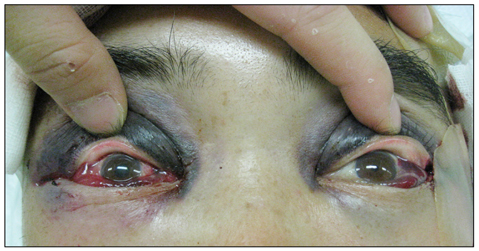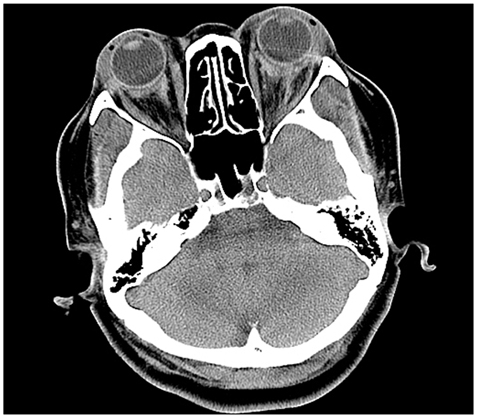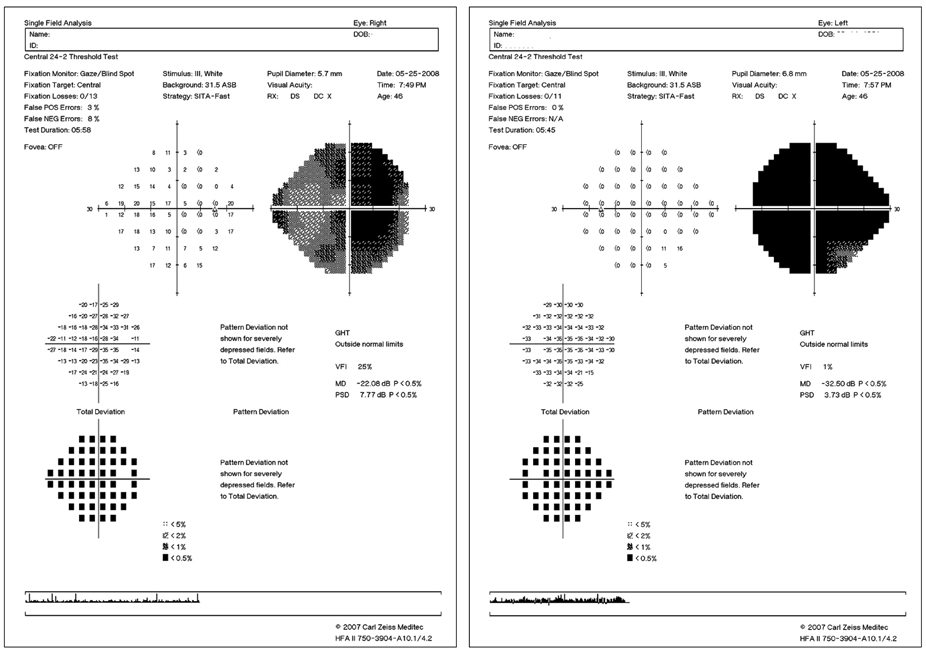Korean J Ophthalmol.
2010 Dec;24(6):380-383. 10.3341/kjo.2010.24.6.380.
Bilateral Retrobulbar Hemorrhage and Visual Loss Following Traumatic Asphyxia
- Affiliations
-
- 1Department of Ophthalmology, Ulsan University Hospital, Ulsan University College of Medicine, Ulsan, Korea. yimjinho@hanmail.net
- 2Department of Radiology, Samsung Medical Center, Sungkyunkwan University School of Medicine, Seoul, Korea.
- KMID: 1769096
- DOI: http://doi.org/10.3341/kjo.2010.24.6.380
Abstract
- Retrobulbar hemorrhage and permanent visual loss are rare presentations following traumatic asphyxia. In this case, bilateral permanent visual disturbance developed in a woman after chest-crushing trauma without direct trauma to the orbits. A computed tomography scan confirmed bilateral retrobulbar hemorrhages. An ophthalmologic exam revealed bilateral subconjunctival hemorrhages and severe lid edema. Despite high-dose steroid therapy, visual recovery was limited, and optic nerve atrophy developed. Ischemia of the optic nerve associated with retrobulbar hemorrhage may be postulated as one of the causes of permanent visual impairment following traumatic asphyxia.
MeSH Terms
Figure
Reference
-
1. Williams JS, Minken SL, Adams JT. Traumatic asphyxia--reappraised. Ann Surg. 1968. 167:384–392.2. Heuer GJ. Traumatic asphyxia with especial reference to its ocular and visual disturbances. Surg Gynecol Obstet. 1923. 36:686–696.3. Parker FJ. Optic atrophy from traumatic asphyxia with report of a case. Arch Ophthalmol. 1911. 11:159–162.4. Purdy RH, Cogbill TH, Landercasper J, Ryan DK. Temporary blindness associated with traumatic asphyxia. J Emerg Med. 1988. 6:373–376.5. Shamblin JR, Mcgoon DC. Acute thoracic compression with traumatic asphyxia. Report of six cases. Arch Surg. 1963. 87:967–975.6. Reichert FL, Martin JW. Traumatic asphyxia: experimental and clinical observations with a report of a case with concomitant paraplegia. Ann Surg. 1951. 134:361–368.7. Sandiford JA, Sickler D. Traumatic asphyxia with severe neurological sequelae. J Trauma. 1974. 14:805–810.8. Jongewaard WR, Cogbill TH, Landercasper J. Neurologic consequences of traumatic asphyxia. J Trauma. 1992. 32:28–31.9. Macnab AJ, Baldwin GA, McCormick AQ, Flodmark O. Proptosis and diplopia following traumatic asphyxia. Ann Emerg Med. 1987. 16:1289–1290.10. Baldwin GA, Macnab AJ, McCormick AQ. Visual loss following traumatic asphyxia in children. J Trauma. 1988. 28:557–558.11. Schabdach DG, Goldberg SH, Breton ME, et al. An animal model of visual loss from orbital hemorrhage. Ophthal Plast Reconstr Surg. 1994. 10:200–205.12. Furuya Y. Experimental traumatic asphyxia (1)--grades of thoracic compression and mortality. Igaku Kenkyu. 1981. 51:117–119.
- Full Text Links
- Actions
-
Cited
- CITED
-
- Close
- Share
- Similar articles
-
- A case of Traumatic Asphyxia Associated with Ophthalmic Manifestation
- Central Retinal Artery Occlusion Without Retrobular Hemorrhage after Retrobulbar Anesthesia
- Retrobulbar Hematoma in Blow-Out Fracture after Open Reduction
- Transient Visual Loss after Retrobulbar Anesthesia in the Advanced Glaucoma Patients
- A Case Report of Bilateral Retrobulbar Hemorrhage after Lower Blepharoplasty




